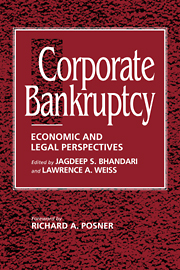Book contents
- Frontmatter
- Contents
- List of tables and figures
- Foreword by the HONORABLE RICHARD A. POSNER
- Preface
- Part I The role of credit
- Part II Bankruptcy as a reflection of the creditors' implicit bargain
- Part III Beyond the basic creditors' bargain
- Part IV Workouts or bargaining in the shadow of bankruptcy
- Part V Alternatives to bankruptcy and the creditors' bargain
- Part VI Experience of other countries
- Index
Part V - Alternatives to bankruptcy and the creditors' bargain
Published online by Cambridge University Press: 10 December 2009
- Frontmatter
- Contents
- List of tables and figures
- Foreword by the HONORABLE RICHARD A. POSNER
- Preface
- Part I The role of credit
- Part II Bankruptcy as a reflection of the creditors' implicit bargain
- Part III Beyond the basic creditors' bargain
- Part IV Workouts or bargaining in the shadow of bankruptcy
- Part V Alternatives to bankruptcy and the creditors' bargain
- Part VI Experience of other countries
- Index
Summary
Despite the arguable benefits from breaches in absolute priority described by the chapters in Part III and the possibility of private workouts or expedited bankruptcy proceedings described by the chapters in Part IV, the bankruptcy reorganization process is costly for many firms. A number of chapters in Part II provide details about those costs. This part explores the possibility that alternatives to bankruptcy can provide investors with the benefits from the bankruptcy process without the costs that this process imposes on at least some firms.
The first five chapters in this part explore the idea that market valuations can simplify the insolvency process. If the market established a value for an insolvent firm's assets, many of the disputed issues in a bankruptcy reorganization would disappear. In the simplest case, a bankruptcy court could auction an insolvent firm for cash, then distribute the cash to claimants in accordance with the claimants' contractual priorities. The purchaser and not the court would have the problem of restructuring the firm's finances. And the court would not have to decide the value of the property it distributed; there can be no debate over the value of cash. With this theme of simplification in mind Michael Jensen, “Corporate Control and the Politics of Finance,” Douglas G. Baird, “The Uneasy Case for Corporate Reorganizations,” Mark J. Roe, “Bankruptcy and Debt: A New Model for Corporate Reorganization,” and Lucian A. Bebchuk “A New Approach to Corporate Reorganizations” offer various schemes to value an insolvent firm through the sale or distribution of unvalued interests in a bankrupt firm.
- Type
- Chapter
- Information
- Corporate BankruptcyEconomic and Legal Perspectives, pp. 327 - 328Publisher: Cambridge University PressPrint publication year: 1996



